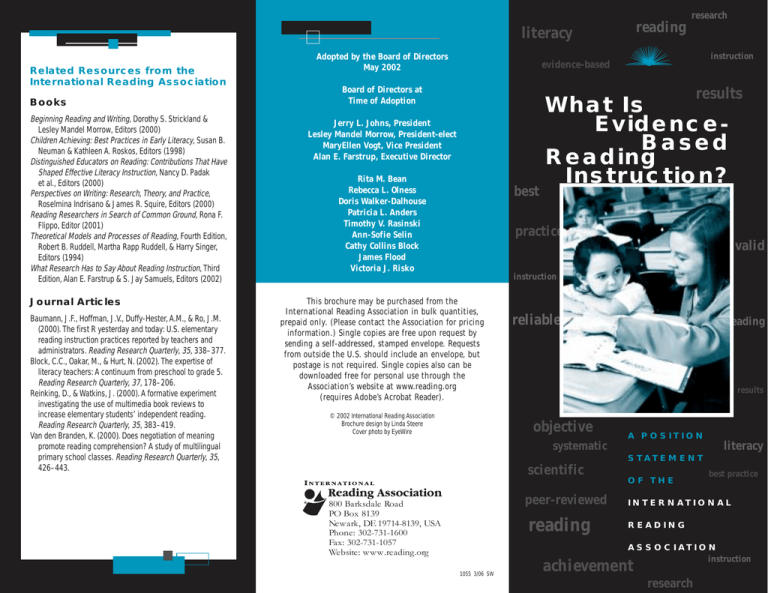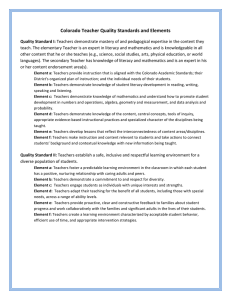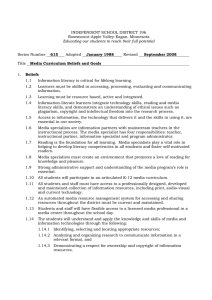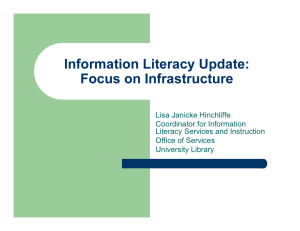Document 12238750
advertisement

research reading literacy Related Resources from the International Reading Association Books Beginning Reading and Writing, Dorothy S. Strickland & Lesley Mandel Morrow, Editors (2000) Children Achieving: Best Practices in Early Literacy, Susan B. Neuman & Kathleen A. Roskos, Editors (1998) Distinguished Educators on Reading: Contributions That Have Shaped Effective Literacy Instruction, Nancy D. Padak et al., Editors (2000) Perspectives on Writing: Research, Theory, and Practice, Roselmina Indrisano & James R. Squire, Editors (2000) Reading Researchers in Search of Common Ground, Rona F. Flippo, Editor (2001) Theoretical Models and Processes of Reading, Fourth Edition, Robert B. Ruddell, Martha Rapp Ruddell, & Harry Singer, Editors (1994) What Research Has to Say About Reading Instruction, Third Edition, Alan E. Farstrup & S. Jay Samuels, Editors (2002) Journal Articles Baumann, J.F., Hoffman, J.V., Duffy-Hester, A.M., & Ro, J.M. (2000). The first R yesterday and today: U.S. elementary reading instruction practices reported by teachers and administrators. Reading Research Quarterly, 35, 338–377. Block, C.C., Oakar, M., & Hurt, N. (2002). The expertise of literacy teachers: A continuum from preschool to grade 5. Reading Research Quarterly, 37, 178–206. Reinking, D., & Watkins, J. (2000). A formative experiment investigating the use of multimedia book reviews to increase elementary students’ independent reading. Reading Research Quarterly, 35, 383–419. Van den Branden, K. (2000). Does negotiation of meaning promote reading comprehension? A study of multilingual primary school classes. Reading Research Quarterly, 35, 426–443. Adopted by the Board of Directors May 2002 instruction evidence-based Board of Directors at Time of Adoption results Jerry L. Johns, President Lesley Mandel Morrow, President-elect MaryEllen Vogt, Vice President Alan E. Farstrup, Executive Director Rita M. Bean Rebecca L. Olness Doris Walker-Dalhouse Patricia L. Anders Timothy V. Rasinski Ann-Sofie Selin Cathy Collins Block James Flood Victoria J. Risko best What Is EvidenceBased Reading Instruction? practice valid instruction This brochure may be purchased from the International Reading Association in bulk quantities, prepaid only. (Please contact the Association for pricing information.) Single copies are free upon request by sending a self-addressed, stamped envelope. Requests from outside the U.S. should include an envelope, but postage is not required. Single copies also can be downloaded free for personal use through the Association’s website at www.reading.org (requires Adobe’s Acrobat Reader). © 2002 International Reading Association Brochure design by Linda Steere Cover photo by EyeWire reliable reading results objective A POSITION literacy systematic S TAT E M E N T scientific OF THE peer-reviewed 800 Barksdale Road N PO Box 8139 Newark, DE 19714-8139, USA Phone: 302-731-1600 Fax: 302-731-1057 Website: www.reading.org reading best practice I N T E R N AT I O N A L READING A S S O C I AT I O N 1055 3/06 SW instruction achievement research T here are few instructional tasks more important than teaching children to read. The consequences of low achievement in reading are costly both to individuals and society. Low achievement in literacy correlates with high rates of school dropout, poverty, and underemployment (Snow, Burns, & Griffin, 1998; Wagner, 2000). The far-reaching effects of literacy achievement have heightened the interest of educators and noneducators alike in the teaching of reading. Policymakers, parents, administrators, and teachers seek the same end—to provide literacy instruction that is most likely to lead to high rates of achievement for all children. As we pursue this goal, we must be mindful of the critical lesson provided by investigations of the past and of the present: There is no single instructional program or method that is effective in teaching all children to read. Rather, successful efforts to improve reading achievement emphasize identification and implementation of evidence-based practices that promote high rates of achievement when used in classrooms by teachers with diverse instructional styles with children who have diverse instructional needs and interests (Bond & Dykstra, 1967/1997; National Clearinghouse for Comprehensive School Reform, 2001). Also, as we seek effective programs and practices, we must remain mindful of the powerful influence teachers have. Time and again, research has confirmed that regardless of the quality of a program, resource, or strategy, it is the teacher and learning situation that make the difference (Bond & Dykstra, 1967/1997). This evidence underscores the need to join practices grounded in sound and rigorous research with well-prepared and skillful teachers. What does the term evidence-based reading instruction mean? In its simplest form, evidence-based reading instruction means that a particular program or collection of instructional practices has a record of success. That is, there is reliable, trustworthy, and valid evidence to suggest that when the program is used with a particular group of children, the children can be expected to make adequate gains in reading achievement. Other terms that are sometimes used to convey the same idea are research-based instruction and scientifically based research. This relatively simple concept becomes more complicated when we attempt to define the types of evidence that are reliable and trustworthy indicators of effectiveness. The central question is, What counts as evidence of success? In general, educators agree that such evidence should be as follows: • objective—data that any evaluator would identify and interpret similarly • valid—data that adequately represent the tasks that children need to accomplish to be successful readers • reliable—data will remain essentially unchanged if collected on a different day or by a different person • systematic—data that were collected according to a rigorous design of either experimentation or observation • refereed—data that have been approved for publication by a panel of independent reviewers In addition to evaluating the quality of the data by which programs or practices are judged, teachers also must examine the generalizability, or fit, of the evidence. In other words, teachers might ask if the children in their classrooms closely resemble the children from whom the evidence was collected: Are they the same age? Do they have similar language and cultural backgrounds? Do they have similar learning profiles? Teachers might also ask if the learning contexts are the same: Are class sizes and teacher–student ratios similar? Is the allocation of instructional time and resources similar? Do teachers have similar funds of knowledge? Has more than one study produced particular findings? If the answer to all of these questions is yes, then teachers might conclude that there is a good fit and that their students might be expected to make similar achievement gains with the same program or practice. If, however, the answers to some or all of these questions is no, then it is difficult to predict whether similar results might be achieved. Research studies used to collect evidence about programs and practices may have a variety of designs. In general, studies that demonstrate effectiveness using experimental designs (studies that compare results from the program or practices of interest to results from a control group with random assignment to the groups) and quasiexperimental designs (studies that do not use random assignment to the program or comparison group, but use adequate statistical procedures to control preexisting differences) give the strongest evidence of effects of a program or practice on the “average” student—particularly when the studies are carried out in naturalistic environments. Quantitative studies such as these generally investigate program effects on relatively large numbers of students. In addition, they can be aggregated by using meta-analysis. In contrast, qualitative studies typically focus on small samples or on individuals and are especially valuable in helping teachers understand how particular programs or approaches affect individuals who may not represent the mainstream or average student. However, no single study ever establishes a program or practice as effective; moreover, it is the convergence of evidence from a variety of study designs that is ultimately scientifically convincing. When evaluating studies and claims of evidence, educators must not determine whether the study is quantitative or qualitative in nature, but rather if the study meets the standards of scientific research. That is, does it involve “rigorous and systematic empirical inquiry that is data-based” (Bogdan & Biklen, 1992, p. 43)? What is the difference between evidence-based programs and evidence-based practices? and provides an effective template for understanding best literacy practices: The quest to find the “best programs” for teaching reading has a long and quite unsuccessful history. Most notable among such efforts is a group of studies conducted in the mid-1960s that became known as the First-Grade Studies (Bond & Dykstra, 1967/1997). This series of U.S. federally funded investigations examined popular approaches to teaching beginning reading. Included were examinations of basal reading, phonics, language experience, and linguistics approaches to reading instruction. The collection of 27 studies comparing different methods and materials found as many differences between and among teachers using the same program or approach as there were between and among teachers using different programs or approaches, leaving the authors unable to identify a “best” program. Instead, the results led the authors to conclude, Children learn to read by a variety of materials and methods.... No one approach is so distinctly better in all situations and respects than the others that it should be considered the one best method and the one to be used exclusively. (Bond & Dykstra, 1967/1997, p. 416) Indeed, many large studies have come to similar conclusions. For example, consider the recent findings related to the evaluations of Comprehensive School Reform. Once again the focus was on reading programs and methods, and the findings echo those of the First-Grade Studies, that “no models had uniformly positive effects, and no models had uniformly negative or neutral effects. In other words, no model worked in every case and every situation” (National Clearinghouse for Comprehensive School Reform, 2001, p. 2). Despite many attempts at program studies in the years since the First-Grade Studies, and many claims of program excellence, literacy scholars (e.g., Allington, 2001; Stahl, Duffy-Hester, & Stahl, 1998) argue that careful examination of such studies reveals the use of either flawed designs or selective reporting of the available data. Furthermore, attempts to find the “right program” for large-scale implementation is complicated by the diversity of student needs, teaching styles, and classroom conditions that exist in any school or group of schools. Whereas efforts to find “best programs” have centered largely on the materials teachers use, attempts to identify best practices have focused on the actions teachers take and the practices in which they routinely engage students. In contrast to the discrepant findings of studies designed to identify best programs, examinations of best practices have led to highly consistent results when such studies have been rigorously designed and systematically analyzed and compared. The results of the First-Grade Studies again provide a relevant starting place. Although findings failed to show superiority of any particular approach or program, evidence did indicate strong relationships between particular practices and high achievement. Most recently, the National Reading Panel (National Institute of Child Health and Human Development, 2000) took a similar approach to its study of effective instruction of reading, examining evidence related to practices in phonemic awareness, phonics, fluency, vocabulary, and comprehension instruction. They found 22 phonics programs that varied along several dimensions that were effective. The results support a conclusion that it is particular practices and not the specific programs that are effective. Current critical and comprehensive research reviews (e.g., Gambrell & Mazzoni, 1999; Guthrie & Alvermann, 1999; Kamil, Mosenthal, Pearson, & Barr, 2000; National Institute of Child Health and Human Development, 2000; Pressley, Wharton-McDonald, Hampson, & Echevarria 1998; Taylor, Pressley, & Pearson, 2002) indicate widespread agreement among literacy experts concerning the particular literacy practices and experiences in which effective teachers routinely engage children. The following list of 10 researchbased best practices posed by Gambrell and Mazzoni (1999) is representative of the current state of literacy knowledge References Allington, R.L. (2001). What really matters for struggling readers: Designing research-based programs. New York: Longman. Bogdan, R.C., & Biklen, S.K. (1992). Qualitative research for education: An introduction to theory and methods (2nd ed.). Boston: Allyn & Bacon. Bond, G.L., & Dykstra, R. (1997). The cooperative research program in first-grade reading instruction. Reading Research Quarterly, 32, 348–427. (Original work published 1967) Gambrell, L.B., & Mazzoni, S.A. (1999). Principles of best practice: Finding the common ground. In L.B. Gambrell, L.M. Morrow, S.B. Neuman, & M. Pressley, (Eds.), Best Practices in Literacy Instruction (pp. 11–21). New York: Guilford Press. 1. Teach reading for authentic meaning-making literacy experiences for pleasure, to be informed, and to perform a task. 2. Use high-quality literature. 3. Integrate a comprehensive word study/phonics program into reading/writing instruction. 4. Use multiple texts that link and expand concepts. 5. Balance teacher- and student-led discussions. 6. Build a whole-class community that emphasizes important concepts and builds background knowledge. 7. Work with students in small groups while other students read and write about what they have read. 8. Give students plenty of time to read in class. 9. Give students direct instruction in decoding and comprehension strategies that promote independent reading. Balance direct instruction, guided instruction, and independent learning. 10. Use a variety of assessment techniques to inform instruction. (p. 14) What resources might be useful when examining evidence to support particular programs or practices? A list such as the one presented above provides an important starting point in the development of evidencebased reading instruction. But how might we learn more about each of these practices and the steps toward effective implementation? Rigorous, peer-reviewed, comprehensive research syntheses provide an excellent starting place for teachers, administrators, and policymakers who wish to learn more about effective teaching of reading. Such syntheses are important and useful because they are based on comprehensive and systematic reviews of many studies, and allow us to predict outcomes when the practices are used under similar conditions with children similar to those who participated in the reported investigations. There are at least three types of research syntheses: large-scale reviews conducted by a team of researchers appointed by a funding agency; edited handbooks, generally compiled by a team of researchers who invite professional colleagues to provide comprehensive reviews of particular topics within a series of chapters; and individual analyses of a particular topic. Individual analyses may be published as book-length monographs, as articles in refereed research journals, or as chapters in edited volumes. The following list gives examples of these types of works, as well as names of refereed research journals. Large-scale, U.S. federally funded research reviews Anderson, R.C., Hiebert, E.H., Scott, J.A., & Wilkinson, I.A.G. (1985). Becoming a nation of readers: The report of the Commission on Reading. Washington, DC: National Institute of Education. Bond, G.L., & Dykstra, R. (1997). The cooperative research program in first-grade reading instruction. Reading Research Quarterly, 32, 348–427. (Original work published 1967) National Institute of Child Health and Human Development. (2000). Report of the National Reading Panel. Teaching children to read: An evidence-based assessment of the scientific research literature on reading and its implications for reading instruction (NIH Publication No. 00-4769). Washington, DC: U.S. Government Printing Office. (Available at http://www.nichd.nih.gov/publications/nrp/smallbook.htm) Snow, C.E., Burns, M.S., & Griffin, P. (Eds.). (1998). Preventing reading difficulties in young children. Washington, DC: National Academy Press. Edited handbooks Barr, R., Kamil, M.L., Mosenthal, P.B., & Pearson, P.D. (Eds.). (1991). Handbook of reading research (Vol. 2). White Plains, NY: Longman. Guthrie, J.T., & Alvermann, D.E. (Eds.). (1999). Engaged reading: Processes, practices, and policy implications. New York: Teachers College Press. Hayes, D.A. (1997). Models of professional practice in teacher thinking. In S.A. Stahl & D.A. Hayes (Eds)., Instructional models in reading (pp. 31–58). Mahwah, NJ: Erlbaum. Kamil, M.L., Mosenthal, P.B., Pearson, P.D., & Barr, R. (2000). Handbook of reading research (Vol. 3). Mahwah, NJ: Erlbaum. National Clearinghouse for Comprehensive School Reform. (2001). Taking stock: Lessons on comprehensive school reform from policy, practice, and research. Benchmarks, 2, 1–11. National Institute of Child Health and Human Development. (2000). Report of the National Reading Panel. Teaching children to read: An evidence-based assessment of the Flood, J., Lapp, D., Squire, J.R., & Jensen, J.M. (Eds.). (2002). Handbook of research on teaching the English language arts (2nd ed.). Mahwah, NJ: Erlbaum. Kamil, M.L., Mosenthal, P.B., Barr, R., & Pearson, P.D. (Eds.). (2000). Handbook of reading research (Vol. 3). Mahwah, NJ: Erlbaum. Neuman, S.B., & Dickinson, D.K. (Eds.). (2001). Handbook of early literacy research. New York: Guilford. Pearson, P.D., Barr, R., Kamil, M.L., & Mosenthal, P.B. (Eds.). (1984). Handbook of reading research. New York: Longman. Research journals American Educational Research Journal Journal of Educational Research Journal of Learning Disabilities Journal of Literacy Research Reading Psychology Reading Research and Instruction Reading Research Quarterly Remedial and Special Education Recommendations The challenge that confronts teachers and administrators is the need to view the evidence that they read through the lens of their particular school and classroom settings. They must determine if the instructional strategies and routines that are central to the materials under review are a good match for the particular children they teach. That is, are the instructional practices likely to provide their students with the types of experiences that research predicts will result in successful reading? The list of best practices in literacy presented previously may be used to frame questions that will be useful when considering whether there is a good fit between the program or approach under examination and a particular school or classroom setting. The International Reading Association recommends teachers and administrators ask the following questions when reviewing materials: • Does this program or instructional approach provide systematic and explicit instruction in the particular strategies that have been proven to relate to high rates of achievement in reading for the children I teach? • Does the program or instructional approach provide flexibility for use with the range of learners in the various classrooms where it will be used? Are there assessment tools that assist teachers in identifying individual learning needs? Are there a variety of strategies and activities that are consistent with diverse learning needs? • Does the program or instructional approach provide a collection of high-quality literary materials that are diverse in level of difficulty, genre, topic, and cultural representation to meet the individual needs and interests of the children with whom it will be used? In addition to examining the match between the instructional approach or program and the children they teach, administrators and teachers also must consider the match between the instructional approach or program and the resources available for implementation (e.g., Hayes, 1997; Richardson, 1994). Questions such as the following may help teachers and administrators assess appropriateness of resources and professional development opportunities: • What instructional personnel will be required to effectively implement the program or instructional approach? That is, can the program be implemented by a classroom teacher alone, or will it require additional instructional personnel within or outside the classroom? • What types of professional development will be necessary for effective implementation of the program or instructional approach? • What adjustments to existing academic programs and practices will be necessary for effective implementation of the program or instructional approach? scientific research literature on reading and its implications for reading instruction (NIH Publication No. 004769). Washington, DC: U.S. Government Printing Office. (Available http://www.nichd.nih.gov/publications/nrp/smallbook.htm) Pressley, M., Wharton-McDonald, R., Hampson, J.M., Echevarria, M. (1998). The nature of literacy instruction in ten grade 4–5 classrooms in upstate New York. Scientific Studies of Reading, 2, 159–194. Richardson, V. (1994). Teacher change and the staff development process: A case study in reading instruction. New York: Teachers College Press. Snow, C.E., Burns, M.S., & Griffin, P. (1998). Preventing reading difficulties in young children. Washington, DC: National Academy Press. Stahl, S.A., Duffy-Hester, A.M., & Stahl, K.A.D. (1998). Everything you wanted to know about phonics (but were afraid to ask). Reading Research Quarterly, 33, 338–355. Taylor, B.M., Pressley, M.P., & Pearson, P.D. (2002). Research-supported characteristics of teachers and schools that promote reading achievement. In B.M. Taylor & P.D. Pearson (Eds.), Teaching reading: Effective schools, accomplished teachers (pp. 361–373). Mahwah, NJ: Erlbaum. Wagner, D.A. (2000). EFA 2000 thematic study on literacy and adult education: For presentation at the World Education Forum, Dakar (April 2000). Philadelphia: International Literacy Institute.






